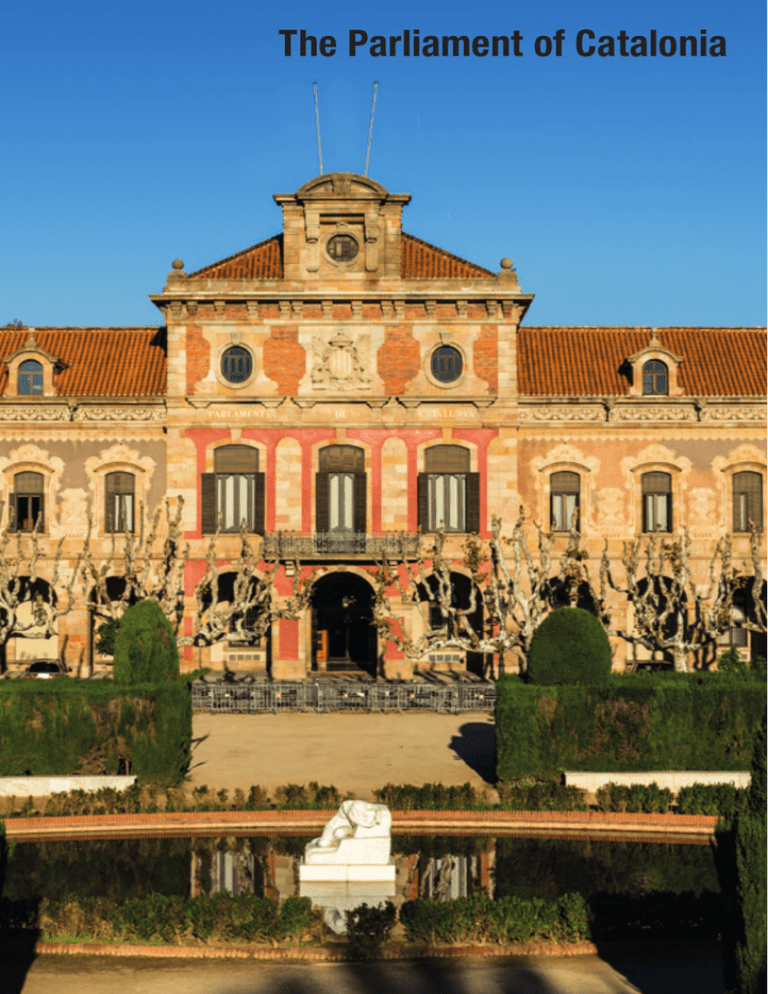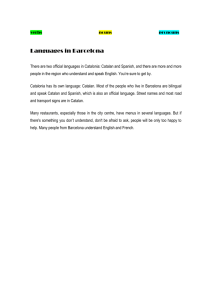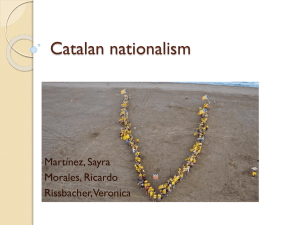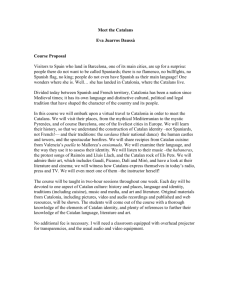The Parliament of Catalonia
advertisement

The Parliament of Catalonia One of the oldest parliaments in the world The Catalan Parliament dates back to the 11th century, with the assemblies of pau i treva (peace and truce) and the Cort comtal (Court of counts) of Barcelona. Under the reign of James I the Conqueror (1213-1276), and as a result of the number of members being increased, the Cort comtal became Corts Generals de Catalunya (General Courts of Catalonia). However, the decisive step towards consolidating this system of government was taken by Peter II the Great (1276-1285) who, by means of the constitution known as Volem, estatuïm (Our wish, our law), established an approved system of sovereignty characteristic of medieval and modern Catalan constitutional law. The Parliament represents the plurality of the Catalan people and is therefore key to its political life, holding debates and taking decisions that affect the everyday lives of the people living in Catalonia. The Parliament is made up of a single chamber or house composed of 135 members chosen democratically via proportional representation. It is renewed every 4 years but the President of the Generalitat can dissolve the legislature before the end of this period and call new elections. During the reign of Peter III the Ceremonious (1336-1387) the Diputació del General was created, which gradually acquired autonomy and executive and governmental powers until, in the 16th and 17th century, it acted as the government for the Principality of Catalonia. Philip V, the first monarch of the Bourbon dynasty, respected the rights of the Catalan people by holding the Corts or parliamentary assemblies until the War of Succession broke out (1702-1714), the result of a conflict of dynastic succession to the throne of Castile and Catalonia-Aragon. Catalonia supported the Archduke Charles of Austria and recognised him as king, but his defeat in the war led to Philip V abolishing all Catalan public rights and Catalan institutions via the decree known as the Decret de Nova Planta (New Rule). The Parliament Two centuries later, the association known as the Mancomunitat de Catalunya (Commonwealth of Catalonia) (1914-1925) made a first attempt at recuperating selfgovernment with Enric Prat de la Riba as its leader. But it was abolished after the coup d’état by General Miguel Primo de Rivera and the implementation of a dictatorship. When the Second Spanish Republic was proclaimed (1931) a provisional Catalan government was established that took the name of the Generalitat de Catalunya, in memory of the old institution of self-government, the Diputació del General. Its institutions were recovered soon afterwards thanks to the Statute of Autonomy of 1932, legitimising and providing a structure for self-government. This self-government was institutionalised by means of a legislative body (the Parliament of Catalonia), an executive body (the President of the Gene­ralitat and the Consell Executiu, or Cabinet) and a limited judicial body (the Tribunal de Cassació, or Supreme Court of Appeal). The triumph of the revolt against the Spanish Republic and the consolidation of General Franco’s dictatorship (1939-1975) once again entailed the abolition of Catalan political autonomy and its institutions. In the process of re-establishing democracy in Spain, a new constitution for the sta­te and a new statute for Catalonia were approved, preceded by numerous civil demonstrations claiming freedom, amnesty and a Statute of Autonomy, and the President of the Generalitat, Josep Tarradellas building opens its doors to you (1977), returned from exile, thereby recuperating the institutions of self-government. On the 20 th of March 1980 elections were held to set up a new Parliament of Catalonia. The Parliament is the fundamental institution of the Generalitat, which is the institutional ­system that goes to make up the political structure of Catalonia’s self-govern­ment. The Parliament passes laws and approves the Generalitat’s budgets, as well as promoting and controlling government actions. It elects the President of the Generalitat and approves, guides and legitimises his or her programme. The President of the Generalitat and the Government are politically responsible before the Parliament. The site of the Parliament: a little history... After the Catalan defeat on the 11th of September 1714, Philip V ordered the construction of a fort to control the city. Today three of the original buildings remain from that military citadel, located around the parade ground: the governor’s palace (today Verdaguer Secondary School), the chapel (today a military parish) and the arsenal, designed by the military architect Próspero de Verboom, which has been the site of the Parliament since 1932. In 1869 General Joan Prim donated the citadel to the city of Barcelona. Work immediately started on demolishing the walls and most of the military buildings to make the Ciutadella Park, designed by Josep Fontserè. In 1889 the municipal architect Pere Falqués adapted the arsenal as a royal palace to provide the king and queen of Spain with a residence in Barcelona, but it was never inhabited by them. Inspired by the Paris Opera House, Falqués gave the building an eclectic ornamental design that signalled the beginnings of Art Nouveau. Many elements (shields, ironwork, mouldings, the sgraffiti on the facade, etc.), as well as the peculiar layout of the rooms and some of the areas still existing in the building (e.g. the main staircase and the ballroom, today reconverted into the sala de passos perduts, or hall of the lost steps) remind us of its original royal intentions. In 1900 Barcelona City Council decided to use the building as the Municipal Art Museum and it was extended with two wings on either side to hold all the art collections. In 1932 Barcelona City Council approved its use as the site for the Parliament. The decorator Santiago Marco was in charge of the adap­ tation work. In 1939, with the defeat of the Second Spanish Republic, the building regained its original use as military barracks, but from 1945 onwards it once again held collections from the Museum of M ­ odern Art and the Numismatic Office of Catalonia. It was therefore used as a museum again. In 1980 Barcelona City Council approved the partial assignment of the building, which was restored and adapted to be ready for the start of the first legislature of the newly re-established Catalan Parliament. In 2004, finally, the building of the palace was returned completely to the Parliament of Catalonia. AULA PA R L A M E N T Aula Parlament is the platform for citizen participation with all the educational and dissemination activities made available to citizens by the Parliament of Catalonia. We invite you to take part in the workshops, seminars and other activities for: –– Schools –– Universities –– Teachers –– Other groups We also organize visits for: –– Individual visitors –– Schools –– Universities –– Other groups For more information Parc de la Ciutadella, s/n 08003 Barcelona +34 933 046 500 www.parlament.cat Sobrequés, J.; Vicens, F.; Pitarch, I. E. El Parlament de Catalunya. Barcelona: 5th edition. Parliament of Catalonia, 2004. Sureda, J. (ed.). El Palau del Parlament. Barcelona: Parliament of Catalonia, 2005. Photos by Pepe Navarro and Lluís Carbonell (cover page) · DL: B.8148-2015 You can check availability and reserve online at: www.parlament.cat/aulaparlament.


